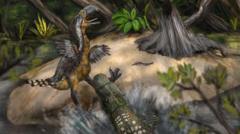The leg bone of a colossal avian predator known as a terror bird, discovered in Colombia, reveals fascinating evidence of a deadly encounter with an even larger predator. Scientists have identified teeth marks matching an extinct caiman species, signaling a battle that could have resulted in the birds’ demise approximately 13 million years ago.
The terror bird, towering at heights exceeding 2.5 meters and famed for its powerful legs and sharp beak, once traversed the humid swamps of the Tatacoa Desert, a region that now hosts rich fossil deposits from the Middle Miocene epoch. This period, characterized by vibrant ecosystems, provided an idyllic hunting ground for these formidable birds and their contemporaries.
Palaeontologists conducted a detailed analysis of the teeth imprints found on the fossilized bone, matching them with collections of caiman skulls and teeth to conclude that the marks belonged to **Purussaurus neivensis**, an enormous crocodilian species measuring up to five meters in length. The research team, led by Andres Link from Universidad de Los Andes, emphasizes the significance of this remarkable find, which showcases rare evidence of interaction between extinct apex predators in their natural habitat.
The bone was initially unearthed by local fossil collector César Augusto Perdomo over 15 years ago. Further examination by the researchers uncovered the critical health information—lack of healing on the bone implying that the terror bird likely died in the struggle, marking its final moments on Earth.
Talent in natural history research stems from collaborations such as this, which allow scientists to gain deeper insights into the complexities of ancient ecosystems. Dr. Link notes that understanding these predator dynamics alters previous perceptions of the terror bird's vulnerability in the face of equally lethal competitors.
In revealing the delicate balance of predator and prey in ancient environments, this study not only shines a light on the life and death of these magnificent creatures but also enriches the narrative of biodiversity long before humans walked the Earth. As Dr. Link reflects, “Every piece of a body helps us to understand so much about life on the planet in the past.” Such discoveries continue to illustrate how a single fossil can unveil layers of historical context shaping the understanding of evolution and survival in ancient times.
The terror bird, towering at heights exceeding 2.5 meters and famed for its powerful legs and sharp beak, once traversed the humid swamps of the Tatacoa Desert, a region that now hosts rich fossil deposits from the Middle Miocene epoch. This period, characterized by vibrant ecosystems, provided an idyllic hunting ground for these formidable birds and their contemporaries.
Palaeontologists conducted a detailed analysis of the teeth imprints found on the fossilized bone, matching them with collections of caiman skulls and teeth to conclude that the marks belonged to **Purussaurus neivensis**, an enormous crocodilian species measuring up to five meters in length. The research team, led by Andres Link from Universidad de Los Andes, emphasizes the significance of this remarkable find, which showcases rare evidence of interaction between extinct apex predators in their natural habitat.
The bone was initially unearthed by local fossil collector César Augusto Perdomo over 15 years ago. Further examination by the researchers uncovered the critical health information—lack of healing on the bone implying that the terror bird likely died in the struggle, marking its final moments on Earth.
Talent in natural history research stems from collaborations such as this, which allow scientists to gain deeper insights into the complexities of ancient ecosystems. Dr. Link notes that understanding these predator dynamics alters previous perceptions of the terror bird's vulnerability in the face of equally lethal competitors.
In revealing the delicate balance of predator and prey in ancient environments, this study not only shines a light on the life and death of these magnificent creatures but also enriches the narrative of biodiversity long before humans walked the Earth. As Dr. Link reflects, “Every piece of a body helps us to understand so much about life on the planet in the past.” Such discoveries continue to illustrate how a single fossil can unveil layers of historical context shaping the understanding of evolution and survival in ancient times.



















